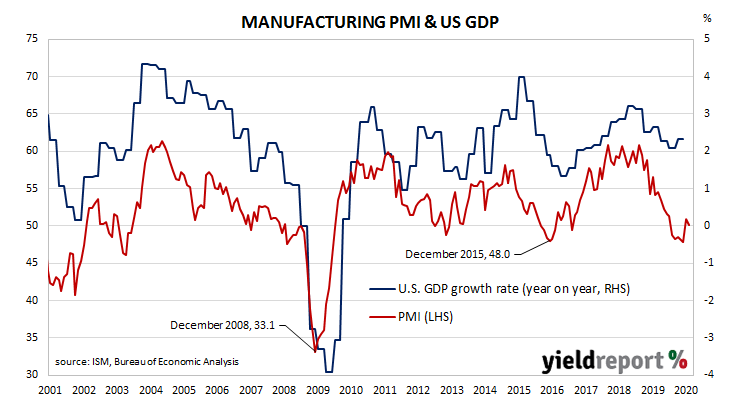US purchasing managers’ indices (PMIs) have been sliding since August 2018, albeit from elevated levels. After reaching a cyclical peak in September 2017, manufacturing PMI readings went sideways for a year before they started a downtrend. Readings stabilised after a truce of sorts was made with the Chinese regarding trade in late 2019. The latest reading implies US manufacturing activity is still expanding, but only barely.
According to the latest Institute of Supply Management (ISM) survey, its Purchasing Managers Index recorded a reading of 50.1 in February, less than the market’s expected figure of 50.5 and down from January’s final reading of 50.9. The average reading since 1948 is 52.9 and any reading below 50 implies a contraction.
The ISM’s Tim Fiore said, “Comments from the panel were generally positive, with sentiment cautious compared to January. The PMI remained in expansion territory but at a weak level.” US Treasury yields generally increased, although this was likely due to rapidly rising expectations of central banks acting to mitigate the economic fallout from coronavirus infections. By the end of the day, the 2-year Treasury bond yield had slipped 1bp to 0.91%, the 10-year yield had ticked up 1bp to 1.16% while the 30-year yield gained 4bps to 1.72%.
US Treasury yields generally increased, although this was likely due to rapidly rising expectations of central banks acting to mitigate the economic fallout from coronavirus infections. By the end of the day, the 2-year Treasury bond yield had slipped 1bp to 0.91%, the 10-year yield had ticked up 1bp to 1.16% while the 30-year yield gained 4bps to 1.72%.
ANZ economist Adelaide Timbrell noted slowing delivery times posed a concern. “Given COVID-19 disruption only recently became a significant global risk and a headwind to domestic momentum in the US, we’ll likely have to wait for another month of data before we start to see significant impacts.” She said the report indicated delivery times had “slowed owing to delays in receiving inputs.”

